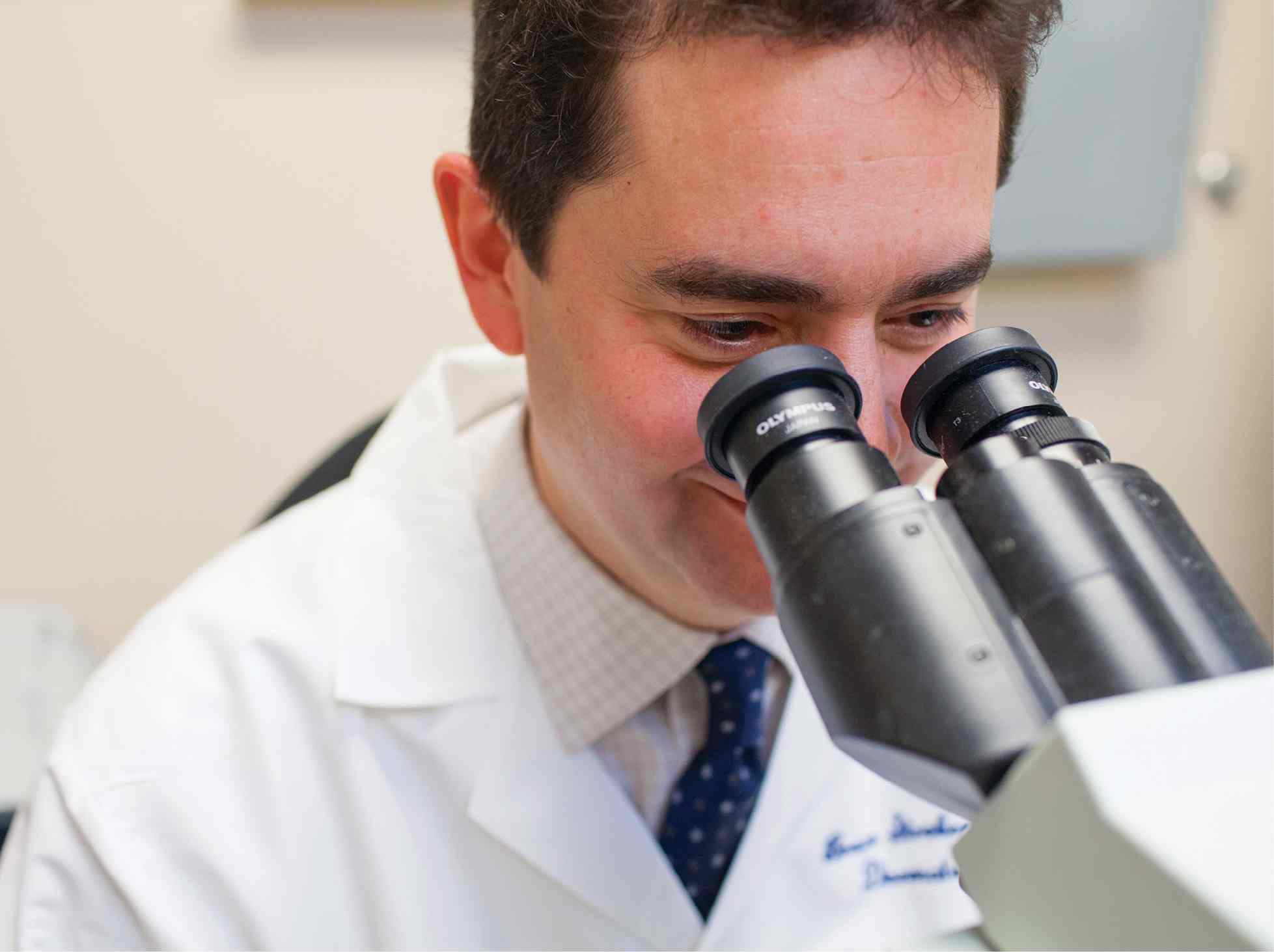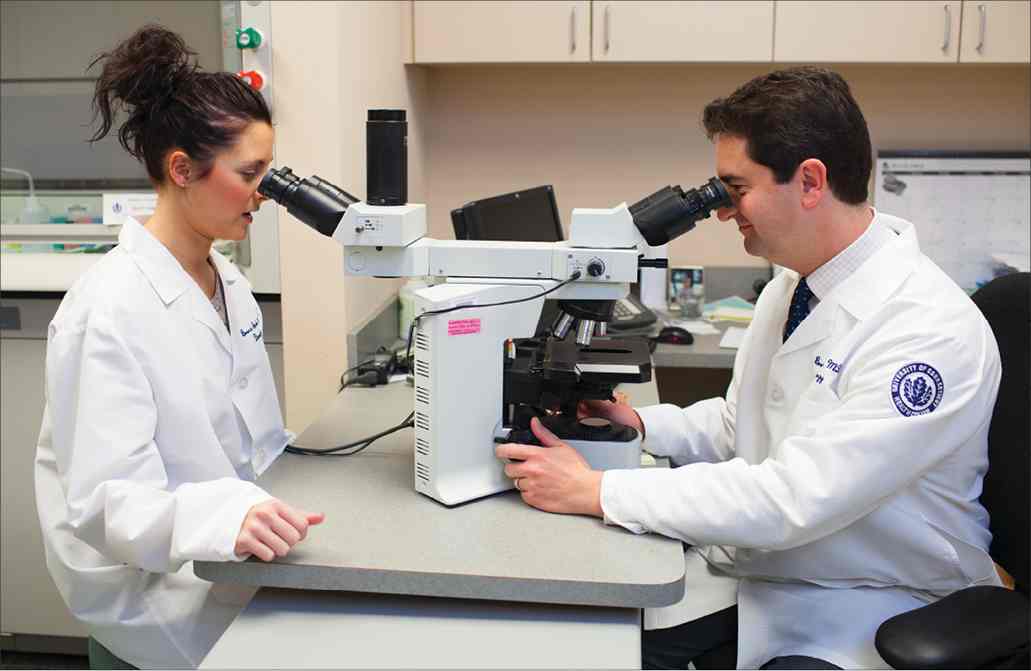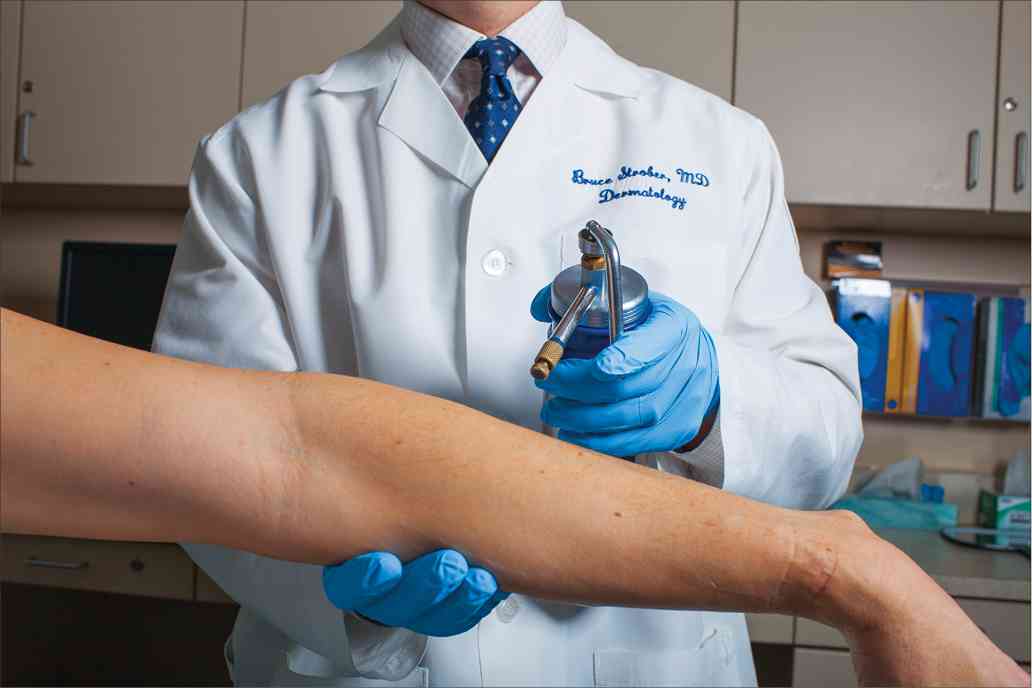|
|
| Bruce Strober, MD, PhD |
By Denise Mann
Dermatologist Bruce Strober, MD, PhD, changes lives
Patients don’t come to see Bruce Strober, MD, PhD, to eradicate crow’s feet or fill in marionette lines. They don’t want to discuss puffiness in their tear troughs or hear about the latest in laser skin resurfacing, either.
Instead, Strober’s patients want to look and feel normal. That’s not too much to ask, is it? Unfortunately, it can be easier said than done for individuals who have moderate-to-severe plaque psoriasis, severe blistering disorders, disfiguring acne, scarring alopecia, or a host of other not-quite-so-sexy or easy-to-treat skin conditions.
As an associate professor of dermatology and director of clinical trials at the University of Connecticut in Farmington, Conn, Strober is what is colloquially known as a bread-and-butter medical dermatologist. And while many of his dermatology residency buddies started out on the very same path, changes in reimbursement patterns and an economy that is barely treading water has made it increasingly difficult for dermatologists to focus solely on skin diseases and conditions.
Bread & Butter Dermatologist
Strober, however, is staying the course. “I went to medical school to treat patients with diseases, and I always felt that this was in line with my temperament and interests,” he says. “The express reason for me being on faculty at University of Connecticut and NYU-Langone Medical Center were to take care of patients with severe dermatologic conditions,” he says. Prior to joining the faculty at University of Connecticut, Strober was an assistant professor of dermatology and co-director of the Psoriasis and Psoriatic Arthritis Center at New York University at NYU-Langone Medical Center in New York City.
According to the American Academy of Dermatology’s (AAD) 2012 Practice Profile Survey, on average, a dermatologist spends 8% of their patient care time on cosmetic dermatology.
 |
 |
| Strober’s research may help cure psoriasis. |
Not Strober. “I specifically treat severe patients with disease that are debilitated from a quality-of-life standpoint,” he says.
The medical dermatology route is possible in academic, tertiary care practices, but not quite as viable in private practice. “In the real world, if a doctor sees a large number of complex medical dermatology patients, they spend more time with them, yet reimbursement is not commensurate with the effort and risk of using systemic medications, some that come with potential toxicities,” Strober says. Many doctors must supplement their practice by offering cosmetic services such as Botox, microdermabrasion, Restylane, and Fraxel, to name a few top sellers.
AAD President Daniel M. Siegel, MD, a Smithtown, NY-based dermatologist, does not perform purely aesthetic procedures, either, but, like Strober, he doesn’t cast stones at those who do. “It is a diverse specialty,” he says.
For example, dermatologists are stealth diagnosticians. “We notice things on the skin that nobody else sees,” Siegel says. “There is a whole field based on cutaneous manifestations of systemic diseases,” he says. Another big area that often flies under the radar is occupational dermatology, he says.
Medical dermatologists don’t see their names in the press as often as their cosmetic colleagues who are routinely quoted in glossy magazines and seen on such TV shows as The View, The Doctors, and The Dr. Oz show. “In any community, there are very good dermatologists practicing medicine,” Siegel says. “We are in the trenches, and I don’t think we would mind the limelight, but you never see celebrities putting a face on an intractable fungal infection.”
Importantly, there are a number of very good medical dermatologists who do small-scale cosmetics.
“If you spend an hour with a patient who has a severe skin disease or conditions and get reimbursed $60, the numbers just don’t add up,” he says. “You can’t pay the rent and utilities—but if you do a couple of cosmetic treatments with higher compensation, you can afford to
pay these bills,” he says.
 |
| Strober spends the lion’s share of his time with patients. |
More Than Skin Deep
Today, about 70% of Strober’s time is spent seeing patients, and 30% of the time he is doing clinical trials research. He is always teaching—often on his lunch hour.
And, in general, quality of life is what he ultimately tries to improve for his patients, and this can be a moving target based on how patients present and their expectations. The question he asks of himself and the residents under his tutelage is simple: “Is the patient happy with how well they are doing compared to when they first walked in to meet you?”
For the most part, these patients want to be normal. “They want normal skin or normal hair, and if you get them there, they will be satisfied,” he says. “They don’t always care about getting 100% better as much as trying hard to get them there. Patients always value your committed effort.”
Jeffrey J. Crowley, MD, a dermatologist in Bakersfield, Calif, who has known Strober for more than a dozen years, puts it like this: “Bruce loves his patients, and they love him,” he says. “He does not just treat the skin in psoriasis patients; he is interested in decreasing the overall inflammation in that patient. It is that inflammation that leads to an increase in heart disease, metabolic syndrome, arthritis, and other co-morbidities in our patients.”
Strober is modest and humble, but many colleagues and researchers alike believe that the clinical trials research he conducts may lead to a cure or long-term remission for psoriasis. “Psoriasis has evolved into a disease state that we can treat with very good results,” Strober says. “If we employ all of the available US Food and Drug Administration-approved treatments, 85% to 95% of patients with psoriasis can be effectively controlled.”
In the future, this success rate will reach close to 100%, he predicts. Biologics have revolutionized the treatment of psoriasis and other autoimmune diseases, and the pipeline is still bursting. Three agents that inhibit the interleukin-17 (IL-17) pathway are moving toward FDA approval. “It appears all three are going to raise the bar in terms of standard for treatment,” he says. Other promising drugs include targeted IL-23 blockers.
Stelara (ustekinumab) is currently approved for the treatment of moderate-to-severe plaque psoriasis. This agent blocks IL-23 and IL-12, but the new agent is more sophisticated and targeted, he says.
A growing body of research suggests that psoriasis is not just a cutaneous problem. It is linked to heart disease, diabetes, and other systemic illnesses. Autoimmune disease also tends to cluster, meaning that many psoriasis patients may also have inflammatory bowel disease, arthritis, eye inflammation, and/or thyroid disorder.
To treat the whole patient, Strober routinely consults with rheumatologists, opthalmologists, and gastroenterologists.
“Bruce has been at the forefront of a worldwide campaign to study and increase awareness of the systemic nature of psoriasis,” Crowley says. “Bruce is already known worldwide for his research in psoriasis. His prominence will continue to grow.”
 |
| Strober often treats more than skin. |
A Role ModeL
Strober is also one of a handful of doctors who is comfortable using Accutane. While remarkably effective, this drug has been shown to increase risk of birth defects. Manufacturer Roche recalled Accutane in 2009, but generic brands—Amnesteen, Claravis, and Sotret—are still available. Many lawyers are champing at the bit to file class-action lawsuits.
“It is extraordinary, and one of the best medications ever invented—especially for severely affected young people—but the downside is the time commitment and logistics setup that a practice must put in place to monitor its use,” Strober says.
Suntanning remains anathema to Strober, and he will always find time to discuss skin cancer prevention with patients, colleagues, and friends.
“I was just in Hawaii, and some people had children adequately protected and others had kids running around like it was the 1950s and we knew nothing about skin cancer,” he says. “The bigger issue is that their kids are not being raised to care.”
Strober and his wife take pains to make sure their young children are well protected from the sun’s harmful rays. “We religiously dress them in sun-protective clothing so it becomes habit-forming, like brushing their teeth or wearing their seatbelt,” he says.
Still, this message often gets lost on teenagers and young adults. “Vanity comes first,” he says. Strober remains optimistic that something will give—it has to. “Smoking rates have fallen over the last generation,” he says.
While there are some parallels between the two cancer-causing behaviors, it can take more of an effort to avoid sun exposure. “Most people don’t put on enough sunscreen and/or reapply it frequently, and tanned skin is still considered very attractive in many quarters,” he says.
Whether treating psoriasis or acne, or counseling patients about sun avoidance, Strober truly cares for, and about, his patients.
AAD President Siegel puts it best when he says, “Strober is a role model.”
Denise Mann is the editor of Plastic Surgery Practice. She can be reached at [email protected].



